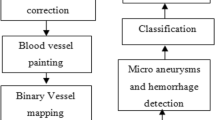Abstract
Heart disease increases the mortality rate in the recent years across the world. So it is necessary to develop a model to predict the heart disease occurrence as early as possible with higher rate of accuracy. In this study, the cardiovascular disease is predicted by non-invasive method with the retinal image data. In this system, the retinal fundus image data are used to predict the heart disease occurrence. Cardiovascular disease can be detected from the changes in microvasculature, which is imaged from retina. The prediction of a disease is by considering features like age, gender, smoking status, systolic blood pressure, diastolic blood pressure, and HbA1c. Risk factors for heart disease occurrence are detected from the microvasculature of segmented retinal fundus image using MATLAB. The main objective of the proposed system is to predict the occurrence of heart disease from retinal fundus image with higher rate of accuracy.
Access this chapter
Tax calculation will be finalised at checkout
Purchases are for personal use only
Similar content being viewed by others
Abbreviations
- ANN:
-
Artificial Neural Network
- AVR:
-
Arteries and Veins Ratio
- CRAE:
-
Central Retinal Artery Equivalent
- CRVE:
-
Central Retinal Vein Equivalent
- CVD:
-
Cardiovascular Disease
- HD:
-
Heart Disease
- SVM:
-
Support Vector Machine
References
Murthy HN, Meenakshi M (2014) Dimensionality reduction using neuro-genetic approach for early prediction of coronary heart disease. In (I4C), pp 329–332. IEEE
Quijano M, Tello JP, Cadena A Heart disease predictor system based on artificial neural network. In (PAHCE), 2013 Pan American, pp 1–4. IEEE
Mahmood AM, Kuppa MR Early detection of clinical parameters in heart disease by improved decision tree algorithm. In (VCON), 2010, pp 24–29. IEEE
Soman KP, Shyam DM, Madhavdas P Efficient classification and analysis of ischemic heart disease using proximal support vector machines based decision trees. In TENCON 2003, vol. 1, pp 214–217. IEEE
Peter TJ, Somasundaram K An empirical study on prediction of heart disease using classification data mining techniques. In (ICAESM), 2012, pp 514–518. IEEE
Banu NS., Swamy S Prediction of heart disease at early stage using data mining and big data analytics: a survey. In (ICEECCOT), 2016, pp. 256–261. IEEE
Sonawane JS, Patil DR Prediction of heart disease using multilayer perceptron neural network. In (ICICES), 2014, pp 1–6. IEEE
Oliveira WS, Ren TI, Cavalcanti GD Retinal vessel segmentation using average of synthetic exact filters and hessian matrix. In (ICIP), pp 2017–2020, IEEE
Panchal P, Bhojani R, Panchal T An algorithm for retinal feature extraction using hybrid approach. Proc Comp Sci 79:61–68
Shylaja SS Algorithmic approach for prediction and early detection of diseases using retinal images. In CGIV'07 2007, pp 501–505. IEEE
Seidelmann et al Retinal vessel calibers in predicting long-term cardiovascular outcomes: the atherosclerosis risk in communities study. Circulation 134(18):1328–1338
Peñafiel et al Associating risks of getting strokes with data from health checkup records using Dempster-Shafer Theory. In (ICACT), 2018, pp 239–246. IEEE
Yekkala I, Dixit S, Jabbar M A prediction of heart disease using ensemble learning and particle swarm optimization. In 2017, pp 691–698. IEEE
Bartolo A, Camilleri KP, Fabri SG, Borg JC Line tracking algorithm for scribbled drawings. In ISCCSP 2008, pp 554–559. IEEE
Sharma A, Rani S An automatic segmentation & detection of blood vessels and optic disc in retinal images. In (ICCSP), 2016, pp 1674–1678. IEEE
Gupta S, Mazumdar SG Sobel edge detection algorithm. Int J Comp Sci Manage Res 2(2):1578–1583
Poplin et al Predicting cardiovascular risk factors from retinal fundus photographs using deep learning. arXiv preprint arXiv:1708.09843
Author information
Authors and Affiliations
Editor information
Editors and Affiliations
Rights and permissions
Copyright information
© 2020 Springer Nature Switzerland AG
About this paper
Cite this paper
Rekha, R., Brintha, V.P., Anushree, P. (2020). Heart Disease Prediction Using Retinal Fundus Image. In: Kumar, L., Jayashree, L., Manimegalai, R. (eds) Proceedings of International Conference on Artificial Intelligence, Smart Grid and Smart City Applications. AISGSC 2019 2019. Springer, Cham. https://doi.org/10.1007/978-3-030-24051-6_71
Download citation
DOI: https://doi.org/10.1007/978-3-030-24051-6_71
Published:
Publisher Name: Springer, Cham
Print ISBN: 978-3-030-24050-9
Online ISBN: 978-3-030-24051-6
eBook Packages: EngineeringEngineering (R0)




